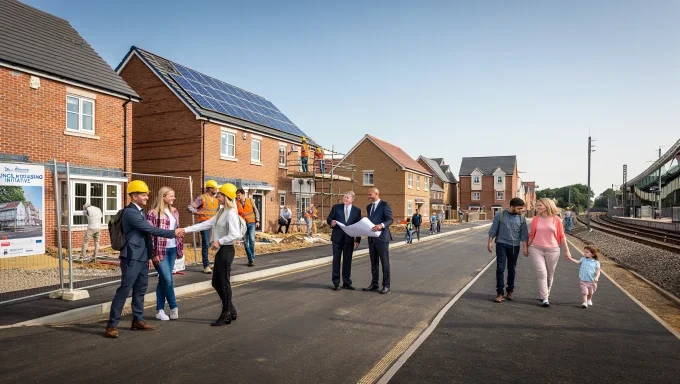As we progress through 2025, a notable evolution is occurring within the UK property investment scene. London, which has long been regarded as the cornerstone of the nation’s genuine estate market, is witnessing a shift in investor attention. Once the automatic choice for those seeking consistent growth and capital appreciation, the capital’s overheated housing market, diminishing yields and stringent entry costs are causing many to rethink their strategies.
Simultaneously, a fresh wave of interest is building around regional cities across the UK. From the Midlands to the North East, previously overlooked urban centres are emerging as attractive alternatives. This trend is being led by more than just economic considerations; it reflects a broadening understanding among investors about where the future of long-term growth lies.

The Shift Towards Regional Investment: Understanding the Appeal of Emerging Property Markets
In 2025, the UK property investment environment is undergoing a significant transformation. While London has traditionally been the focal point of genuine estate investment, investors are increasingly shifting their attention to regional cities across the UK. Factors such as affordability, stronger rental yields, urban regeneration, and shifting demographic patterns are contributing to this change.
This movement towards regional investment isn’t merely a short-term response to economic pressures but a reflection of more structural shifts in how investors assess risk, growth, and return on investment. Cities like Birmingham, Leeds, Manchester, and Newcastle are no longer viewed as secondary options; they are becoming prime targets in their own right.
Rising Costs in London and the Affordability Factor
London’s high property prices have long been a barrier for many investors. As of 2025, the average property price in inner London remains above £700,000, with certain boroughs like Kensington and Chelsea exceeding the £1 million mark. Even outer boroughs offer little reprieve, often commanding prices upwards of £400,000 for modest homes.
This pricing environment makes entry into the London market difficult not only for individual landlords but also for smaller institutional investors. The result is a notable shift in capital flow towards cities where initial investments are significantly lower but yield opportunities remain attractive.
Moreover, in cities like Manchester and Liverpool, investors can purchase multiple properties for the price of one in London, spreading their risk and improving cash flow. These cities offer not only better affordability but also rising tenant demand, further reinforcing their investment appeal.

Rental Yields: The Numbers Tell the Story
Rental yield is a crucial metric for property investors. In London, average gross rental yields have fallen to around 3.5% in 2025 due to high acquisition costs and a slowing rental growth rate. In contrast, cities like Bradford and Nottingham offer yields upwards of 6–8%.
These figures, coupled with lower upfront costs, make regional markets more attractive to investors prioritising rental income. In addition, lower vacancy rates in regional cities, due to consistent tenant demand and housing undersupply, improve yield stability.
Higher yields in these areas also mean investors can recoup their initial investments faster and reinvest profits more effectively. This cycle supports long-term portfolio growth and creates a more predictable income stream.
Urban Regeneration and Infrastructure Development
Many regional cities have benefited from public and private investment aimed at revitalising urban cores and improving infrastructure. Projects like HS2 and the South Bank regeneration in Leeds are improving connectivity and increasing local economies.
Cities such as Liverpool and Birmingham are undergoing transformation through improved transportation, new housing developments, and modernised commercial districts. These improvements are drawing in professionals, students, and businesses alike, making them more attractive for long-term investment.
Additionally, local councils and development authorities are working in partnership with private firms to create mixed-use developments that encourage live-work-play environments. These projects support a strong sense of community and offer lifestyle benefits that rival those of London.

Shifting Demographics and Lifestyle Trends
Younger generations and working professionals are more open to living in regional cities, led by workplace flexibility and lower living costs. Hybrid and remote working models have allowed many to relocate to more affordable and spacious locations.
Student populations and growing family migration trends are also supporting steady rental demand. As a result, property markets in cities like Sheffield, Bristol, and Cardiff are experiencing steady growth in both capital values and tenant demand.
Lifestyle-led migration is becoming increasingly influential in shaping housing preferences. Many individuals and families are prioritising quality of life, access to green space, lower crime rates, and better school systems factors more commonly found outside of the capital.
The appeal of regional cities is further strengthened by cultural amenities, vibrant local economies, and a growing sense of community. These elements are making regional living more attractive and long-term for diverse demographics.

Government Support and Market Incentives
Government schemes such as the Levelling Up agenda and Help to Buy are encouraging homeownership and infrastructure growth outside the capital. Stamp Duty relief for lower-priced homes and support for shared ownership make regional markets more accessible.
These policy shifts are reinforcing the trend toward regional investment by creating more flexible and self-sustaining local economies. Furthermore, targeted initiatives in housing, transport, and digital connectivity are reducing the disparity between London and the rest of the UK.
There is also an increased focus on affordable housing and energy-efficient buildings in regional towns, which aligns with sustainability goals and long-term tenant interest. These investments can improve the value of regional property portfolios over time.
In 2025, many local governments are introducing tax incentives and grant schemes to attract private sector investment in underserved regions. These policies aim to close regional economic gaps and bring jobs, housing, and services to areas that have traditionally lagged behind.
Enterprise zones and economic development hubs are also being promoted as attractive destinations for both commercial and residential property development. Such coordinated strategies improve long-term investment viability by fostering business growth, population inflow, and housing demand in targeted regions.

Evolving Financing Opportunities
Mortgage products customized for regional investment are becoming more common in 2025. Lenders are offering flexible buy-to-let options and competitive interest rates, especially for lower-value properties outside London.
Specialist lenders are also enabling investors to access financing for diverse property types, including HMOs and multi-unit blocks, expanding the scope for portfolio growth in regions with lower capital entry requirements.
Additionally, crowdfunding platforms and investment syndicates are making regional property accessible to smaller investors. This democratisation of property investment allows more people to benefit from the strong performance of regional markets.
In parallel, banks and credit institutions are beginning to recognise the strong fundamentals underpinning regional genuine estate. As a result, they are developing more responsive lending criteria that factor in rental yield potential, local economic health, and infrastructure development, giving investors more use.
Peer-to-peer lending models and fintech-led property investment tools are further changing access to capital. These innovations are creating a more inclusive financing environment and enabling planned investment in properties that offer long-term returns.

Diversification and Investment Strategy
A key advantage of regional investment lies in diversification. Investors are able to spread capital across multiple properties and locations, reducing risk while improving overall portfolio yield.
This approach allows for greater resilience against localised economic downturns and provides more opportunities to customize property types to specific regional demands, such as student accommodation or short-term rentals in tourist-friendly towns.
By diversifying into regions, investors can adapt to shifting market conditions and regulatory environments. It also provides a buffer against national economic shocks, helping to stabilise income streams across varying market cycles.
In addition, regional markets allow for portfolio customisation that meets niche tenant demands, such as co-living spaces for young professionals or accessible housing for retirees. These customized strategies help maximise occupancy and returns.

Long-Term Outlook for Regional Markets
Industry forecasts remain positive for regional UK markets. Analysts project sustained demand led by population growth, continued infrastructure investment, and affordability relative to London.
With cities like Leeds and Manchester positioned as hubs of economic and cultural activity, the long-term growth potential for regional property investments remains strong. Experts predict that the gap between London and other cities in terms of returns and appeal will continue to narrow through the latter half of the decade.
Economic decentralisation and rising interest in the Northern Powerhouse and Midlands Engine initiatives are also leading local job creation, fostering vibrant communities that support long-term tenancy.
As more multinational companies and startups expand outside of London, demand for housing in regional areas will likely continue to rise, strengthening property values and securing investor confidence well into the future.
FAQs
What are the main advantages of investing in regional UK property markets over London in 2025?
Regional markets offer lower entry costs, higher yields, and strong growth potential.
Which UK regional cities offer the highest rental yields in 2025?
Cities like Bradford, Nottingham, and Liverpool are reporting yields of 6–8%.
How do government policies support property investment outside London?
Initiatives like Levelling Up and Stamp Duty relief encourage regional investment.
What are the risks of investing in emerging regional property markets?
Risks include slower resale liquidity and dependence on local economic growth.
How does urban regeneration impact property values in regional cities?
Regeneration projects often lead to demand, increase property values, and attract tenants.
The Future of UK Property Investment
The migration of property investment away from London is a measured response to evolving market conditions in 2025. Investors are seeking value, growth, and income criteria that regional markets increasingly meet. Supported by infrastructure development, changing lifestyles, and government incentives, cities beyond the capital are becoming essential components of the UK’s investment environment.
As regional markets continue to mature, they offer not just alternatives but often superior prospects for return and resilience. With the right strategy and location, investors stand to benefit from the next phase of the UK property cycle.
For those willing to examine beyond London’s borders, the UK property market in 2025 offers strong and resilient opportunities in its regional heartlands. The future of UK property is no longer confined to the capital; it’s being redefined across a diverse and growing national environment.
